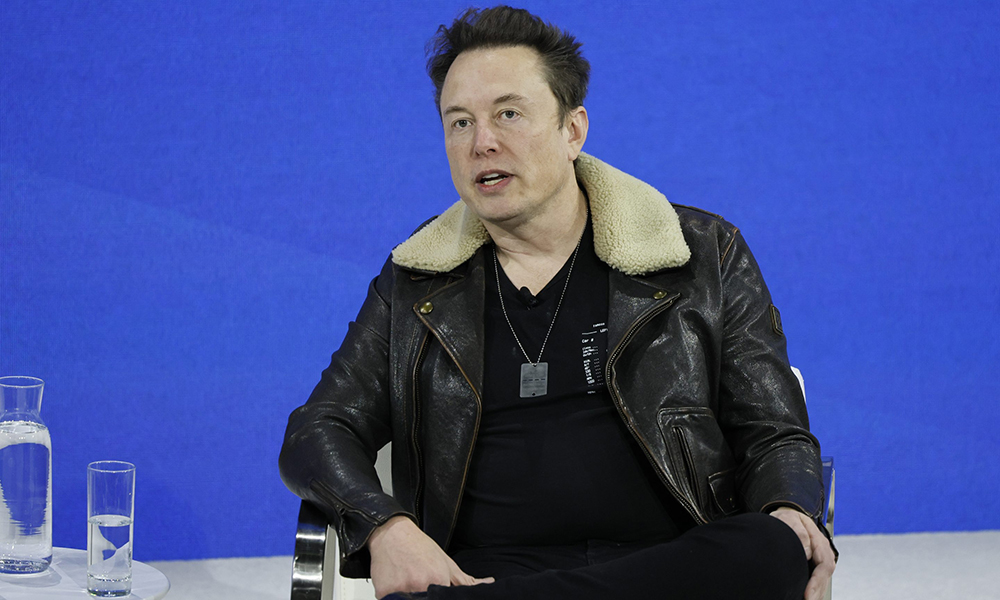
特斯拉(Tesla Inc.)在2023年的表現異常搶眼,其股價在12個月內近乎翻了一番。然而,埃隆·馬斯克的這家電動汽車制造公司在2024年伊始卻一反常態,股價表現之差創歷年同期之最。
特斯拉的市值在2024年的前兩周蒸發了940多億美元。原因并不難理解:這家總部位于美國得克薩斯州奧斯汀的電動汽車制造商遭遇了一系列負面新聞的沖擊,包括汽車租賃巨頭赫茲全球控股公司(Hertz Global Holdings Inc.)對電動汽車態度的180度轉彎、中國產特斯拉價格的再次下調,以及勞動力成本的上漲趨勢。
這一切的背后是電動汽車需求增速的放緩,尤其是在美國市場。
Cowen公司的分析師杰弗里·奧斯本在一次采訪中表示:“投資者對特斯拉的主要擔憂在于增長的停滯不前。”中國特斯拉的降價進一步加劇了這種擔憂,有鑒于中國市場激烈的競爭,電動汽車行業似乎開啟了“價格戰”模式。
特斯拉的市值在今年年初的降幅創下了公司自2010年上市以來的同期之最。按照百分比計算,特斯拉的市值在進入今年1月之后下滑了12%,是自2016年之后表現最差的一年。當時,特斯拉股價在進入1月的前九個交易日下跌了14%。
令其雪上加霜的是,這家電動汽車制造商在短期內扭虧為盈的可能性并不大。
自2023年年初以來,特斯拉一直在通過降價來提振市場需求。受此影響,其豐厚的利潤率不斷遭到侵蝕。不計監管積分,特斯拉汽車第三季度毛利率從一年前的27.9%降至16.3%。然而,隨著其美國工廠工人的漲薪,壓力只會有增無減。
Spear Invest的首席投資官伊萬娜·德列夫斯卡在接受采訪時說:“我們正在經歷電動汽車的周期性低迷,但競爭態勢加劇了周期性壓力,而且這種不利的態勢導致了降價和利潤率暴跌。”
然而禍不單行,據知情人士透露,出于對西方軍事行動和紅海安全的擔憂,特斯拉在給德國柏林工廠發貨時不得不繞道而行,而且在1月29日至2月11日期間將暫停柏林附近工廠的大多數生產任務。
特斯拉投資者經歷的當頭棒喝
特斯拉在2023年10月發布的第三季度財報里首次警告稱,電動汽車需求將有所放緩。此消息一出,全球汽車制造商和供應商亦紛紛發表了悲觀預測,很多汽車制造商還取消了其擴張計劃。
本月早些時候,特斯拉公布了第四季度交付數據,盡管好于分析師預期,但其全球電動汽車銷量仍然落后于中國的比亞迪。
對特斯拉的投資者而言,這一結果無異于當頭棒喝。2023年,其股價表現在標準普爾500指數(S&P 500)里名列第八位。然而,公司自年初至今的股價表現則是倒數第八位。
自然,馬斯克本人也遭受了很大的沖擊。彭博億萬富翁指數(Bloomberg Billionaires Index)稱,盡管這位世界首富在2023年賺取的財富可謂是冠絕全球,但其凈資產在年初至今的這段時間內縮水了230億美元。2023年,馬斯克超越了貝爾納·阿爾諾重回該榜單榜首位置。現如今,杰夫·貝佐斯正在快速逼近,在1月12日收盤時達到了1,790億美元,而馬斯克的凈資產為2,060億美元。
馬斯克凈資產的主體源自于其在特斯拉13%的股份,以及約3.04億美元的可行權股票期權。彭博的財富指數顯示,他還持有太空探索技術公司(SpaceX)約42%的股份,價值約為530億美元。
盡管如此,特斯拉依舊在全球燃油車電動化轉型過程中發揮著關鍵作用。原因在于它到目前為止仍舊領先于潛在的競爭對手。雖然中國比亞迪的銷量已經超過了特斯拉,但收入和利潤依然落后。比亞迪并沒有進入美國市場,而特斯拉仍然是該市場的霸主。
從很多方面來看,特斯拉最大的問題可能在于過往的成功光環以及由此而來的外界期望。隨著投資者的涌入,特斯拉市值迅速膨脹,遠超全球任何一家汽車企業。然而,過高的股價讓特斯拉極易受到負面消息的影響。
這也是眾多支持者認為,特斯拉不應該與傳統車企相比較的原因。對他們來說,特斯拉真正的價值在于未來,而且該公司有望開發出第一輛真正意義上的自動駕駛汽車。唯一的問題在于,特斯拉多年來一直停留在口頭承諾上,而大多數專家認為該技術還需要幾年,甚至幾十年的時間才能夠實現。
Spear公司的德列夫斯卡說:“特斯拉尚未兌現完全自動駕駛和人工智能的承諾,但這些承諾已經體現在了估值里。要撐起7,500億美元的估值,光靠生產汽車是不夠的。”(財富中文網)
——馬特·特納(Matt Turner)、克里斯汀·歐拉姆(Kristine Owram)和愛德華·勒德洛(Edward Ludlow)對本文亦有貢獻。
譯者:馮豐
審校:夏林
特斯拉(Tesla Inc.)在2023年的表現異常搶眼,其股價在12個月內近乎翻了一番。然而,埃隆·馬斯克的這家電動汽車制造公司在2024年伊始卻一反常態,股價表現之差創歷年同期之最。
特斯拉的市值在2024年的前兩周蒸發了940多億美元。原因并不難理解:這家總部位于美國得克薩斯州奧斯汀的電動汽車制造商遭遇了一系列負面新聞的沖擊,包括汽車租賃巨頭赫茲全球控股公司(Hertz Global Holdings Inc.)對電動汽車態度的180度轉彎、中國產特斯拉價格的再次下調,以及勞動力成本的上漲趨勢。
這一切的背后是電動汽車需求增速的放緩,尤其是在美國市場。
Cowen公司的分析師杰弗里·奧斯本在一次采訪中表示:“投資者對特斯拉的主要擔憂在于增長的停滯不前。”中國特斯拉的降價進一步加劇了這種擔憂,有鑒于中國市場激烈的競爭,電動汽車行業似乎開啟了“價格戰”模式。
特斯拉的市值在今年年初的降幅創下了公司自2010年上市以來的同期之最。按照百分比計算,特斯拉的市值在進入今年1月之后下滑了12%,是自2016年之后表現最差的一年。當時,特斯拉股價在進入1月的前九個交易日下跌了14%。
令其雪上加霜的是,這家電動汽車制造商在短期內扭虧為盈的可能性并不大。
自2023年年初以來,特斯拉一直在通過降價來提振市場需求。受此影響,其豐厚的利潤率不斷遭到侵蝕。不計監管積分,特斯拉汽車第三季度毛利率從一年前的27.9%降至16.3%。然而,隨著其美國工廠工人的漲薪,壓力只會有增無減。
Spear Invest的首席投資官伊萬娜·德列夫斯卡在接受采訪時說:“我們正在經歷電動汽車的周期性低迷,但競爭態勢加劇了周期性壓力,而且這種不利的態勢導致了降價和利潤率暴跌。”
然而禍不單行,據知情人士透露,出于對西方軍事行動和紅海安全的擔憂,特斯拉在給德國柏林工廠發貨時不得不繞道而行,而且在1月29日至2月11日期間將暫停柏林附近工廠的大多數生產任務。
特斯拉投資者經歷的當頭棒喝
特斯拉在2023年10月發布的第三季度財報里首次警告稱,電動汽車需求將有所放緩。此消息一出,全球汽車制造商和供應商亦紛紛發表了悲觀預測,很多汽車制造商還取消了其擴張計劃。
本月早些時候,特斯拉公布了第四季度交付數據,盡管好于分析師預期,但其全球電動汽車銷量仍然落后于中國的比亞迪。
對特斯拉的投資者而言,這一結果無異于當頭棒喝。2023年,其股價表現在標準普爾500指數(S&P 500)里名列第八位。然而,公司自年初至今的股價表現則是倒數第八位。
自然,馬斯克本人也遭受了很大的沖擊。彭博億萬富翁指數(Bloomberg Billionaires Index)稱,盡管這位世界首富在2023年賺取的財富可謂是冠絕全球,但其凈資產在年初至今的這段時間內縮水了230億美元。2023年,馬斯克超越了貝爾納·阿爾諾重回該榜單榜首位置。現如今,杰夫·貝佐斯正在快速逼近,在1月12日收盤時達到了1,790億美元,而馬斯克的凈資產為2,060億美元。
馬斯克凈資產的主體源自于其在特斯拉13%的股份,以及約3.04億美元的可行權股票期權。彭博的財富指數顯示,他還持有太空探索技術公司(SpaceX)約42%的股份,價值約為530億美元。
盡管如此,特斯拉依舊在全球燃油車電動化轉型過程中發揮著關鍵作用。原因在于它到目前為止仍舊領先于潛在的競爭對手。雖然中國比亞迪的銷量已經超過了特斯拉,但收入和利潤依然落后。比亞迪并沒有進入美國市場,而特斯拉仍然是該市場的霸主。
從很多方面來看,特斯拉最大的問題可能在于過往的成功光環以及由此而來的外界期望。隨著投資者的涌入,特斯拉市值迅速膨脹,遠超全球任何一家汽車企業。然而,過高的股價讓特斯拉極易受到負面消息的影響。
這也是眾多支持者認為,特斯拉不應該與傳統車企相比較的原因。對他們來說,特斯拉真正的價值在于未來,而且該公司有望開發出第一輛真正意義上的自動駕駛汽車。唯一的問題在于,特斯拉多年來一直停留在口頭承諾上,而大多數專家認為該技術還需要幾年,甚至幾十年的時間才能夠實現。
Spear公司的德列夫斯卡說:“特斯拉尚未兌現完全自動駕駛和人工智能的承諾,但這些承諾已經體現在了估值里。要撐起7,500億美元的估值,光靠生產汽車是不夠的。”(財富中文網)
——馬特·特納(Matt Turner)、克里斯汀·歐拉姆(Kristine Owram)和愛德華·勒德洛(Edward Ludlow)對本文亦有貢獻。
譯者:馮豐
審校:夏林
Tesla Inc. had a blockbuster 2023, as its shares more than doubled in 12 months. But 2024 is starting on a different note, with Elon Musk’s electric vehicle maker off to its worst start to any year — ever.
The company has lost more than $94 billion in market valuation in just the first two weeks of 2024. It’s not hard to figure out why, as the Austin, Texas-based EV maker has been pounded by a barrage of negative news: an about-face on EVs from the car rental giant Hertz Global Holdings Inc., yet another price cut for its cars made in China, and signs of rising labor costs.
All of this comes in the face of slowing growth in demand for EVs, especially in the US.
“Investors’ main concern on Tesla is stagnating growth,” Cowen analyst Jeffrey Osborne said in an interview. The price cuts in China only fan those concerns, because it is starting to look like “a race to the bottom for the EV industry given intense competition in that market.”
The hit to Tesla’s market capitalization to start the year is the biggest the company has seen over a similar period since it went public in 2010. In percentage terms, Tesla’s 12% drop since the start of January is the worst since 2016, when the stock fell 14% over the first nine trading days of the year.
To make matters worse, the odds of an imminent turnaround for the EV maker don’t look good.
Tesla has been cutting prices on its cars aggressively since early 2023 in an effort to boost demand. But the result has been a steady erosion of its once-hefty profit margin. Tesla’s automotive gross margin ex-regulatory credits for the third quarter fell to 16.3% from 27.9% a year ago. And the pressure is only mounting, now that production workers at Tesla’s US plants are getting pay raises.
“We are going through a cyclical downturn for EVs, but competitive dynamics are exacerbating the cyclical pressures,” Ivana Delevska, chief investment officer at Spear Invest, said in an interview. “Price cuts and plummeting margins are all a function of these unfavorable competitive dynamics.”
Adding to the woes, Tesla has had to re-route shipments destined for its Berlin plant after Western military actions and security concerns in the Red Sea, and is suspending most production at its plant near Berlin from Jan. 29 to Feb. 11, according to a person familiar with the matter.
Rude awakening for Tesla investors
Tesla first warned about the deceleration in EV demand during its October third-quarter earnings report. Almost immediately after, automakers and suppliers across the globe chimed in with their own downbeat forecasts. Many carmakers dialed back their plans for expansion.
Then, earlier this month, Tesla reported its fourth-quarter delivery numbers. While they were better than what analysts expected, they put the company behind China’s BYD Co. in global electric-car sales.
The result has been a rude awakening for Tesla investors. Last year, the stock was the eighth best performer in the S&P 500. So far this year, it’s the eighth worst.
Naturally, Musk is taking a big hit personally. The world’s richest person, who gained more wealth in 2023 than anyone else on the planet, has seen his net worth shrink by $23 billion so far this year, according to the Bloomberg Billionaires Index. Musk regained the top spot on Bloomberg’s wealth index last year, overtaking Bernard Arnault, but now Jeff Bezos is rapidly closing in, with $179 billion to Musk’s $206 billion as of January 12’s close.
The bulk of Musk’s net worth comes from his 13% stake in Tesla and about 304 million exercisable stock options. He also owns about 42% of SpaceX, which is valued at about $53 billion, according to Bloomberg’s wealth index.
With all that being said, Tesla remains a key player in the global transition from gas-powered vehicles to largely electric ones. The reason: It’s so far ahead of its potential rivals. China’s BYD may have surpassed Tesla in the number of units sold, but it still lags in revenue and profits. And BYD doesn’t sell cars in the US, where Tesla remains the market leader.
In many ways, Tesla’s biggest problem may be its past success and the hope it generated. As investors piled into the stock, Tesla’s market capitalization ballooned, making it way larger than any other car company in the world. However, with the shares priced for perfection, that also made them highly vulnerable to big reactions to any negative news.
That’s why so many Tesla proponents argue that it shouldn’t be compared to regular car companies. To them, the ultimate true value of the company rests in the future and it’s hope to develop the first truly self-driving vehicles. The only problem is Tesla has been promising this for years, and most experts say the technology is still years, maybe even decades, away.
“Tesla has not been able to deliver on fully autonomous driving and AI promises, which are already embedded in the valuation,” Spear’s Delevska said. “Being simply another automotive manufacturer is not going to cut it for a $750 billion valuation.”
— With assistance from Matt Turner, Kristine Owram, and Edward Ludlow






